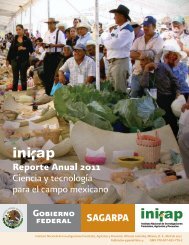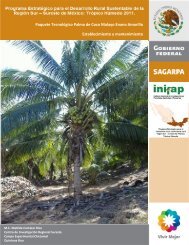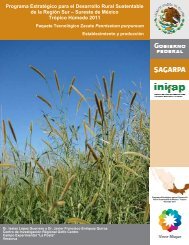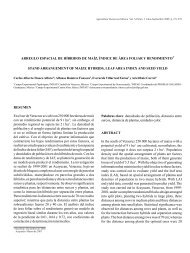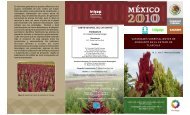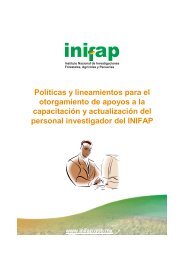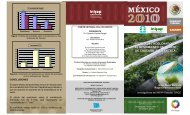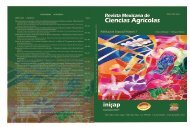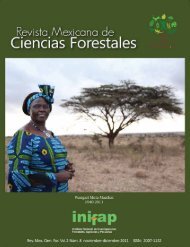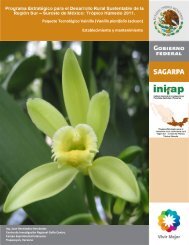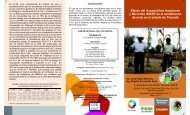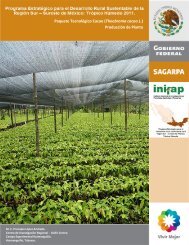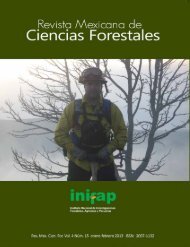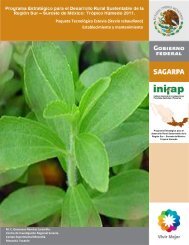artÃÂculos riego, densidad de plantas y fertilización nitrogenada
artÃÂculos riego, densidad de plantas y fertilización nitrogenada
artÃÂculos riego, densidad de plantas y fertilización nitrogenada
You also want an ePaper? Increase the reach of your titles
YUMPU automatically turns print PDFs into web optimized ePapers that Google loves.
Palabras clave: Lycopersicon esculentum,Mill., enemigos naturales,<br />
parasitoi<strong>de</strong>s, <strong>de</strong>predadores, mosca blanca, gusano <strong>de</strong>l fruto, virosis,<br />
atrayentes.<br />
ABSTRACT<br />
The effects of some cultural practices for the conservation of native beneficial<br />
organisms was evaluated in the tomato crop at three locations: Tlacolula,<br />
Suchilquitongo and San Lorenzo Cacaotepec in the Central Valleys of Oaxaca.<br />
Periodical insect counts were carried out on tomato plants grown un<strong>de</strong>r two<br />
treatments, 1) full (periodical) insectici<strong>de</strong> applications and 2) reduced chemical<br />
control. In a second trial, three insect attractants were evaluated: honey, sugar<br />
and Bio-Attrack (commercial). The population of the beneficial organisms was<br />
significantly higher in the experimental plots where pestici<strong>de</strong> applications were<br />
reduced. The application of attractants also significantly increased the presence<br />
of beneficial insects, mainly lady bug beetle (Coccinellidae) and syrphid flies,<br />
particularly when the aphid populations in the experimental plots or in neighbor<br />
fields were low. As a consequence of the increase in the population of beneficial<br />
organisms, the population of pests and their damage to the tomato crop were<br />
reduced.<br />
Key words: Lycopersicum esculentum, parasitoids, predators, whitefly, tomato<br />
fruitworm virus, attractants<br />
RENDIMIENTO DE HIBRIDOS DE CANOLA (Brassica napus L.)<br />
EN DIFERENTES MÉTODOS DE SIEMBRA<br />
YIELD OF CANOLA (Brassica napus L.) HYBRIDS<br />
IN DIFFERENT PLANTING SYSTEMS<br />
Alfredo S. Ortegón Morales,1 Arturo Díaz Franco1 y Alfredo Rodríguez<br />
Castillo2<br />
1MC. Investigadores <strong>de</strong>l Programa Nuevas Opciones. Campo Experimental Río<br />
Bravo, INIFAP. Apdo. Postal 172. 88900 Río Bravo, Tamaulipas, México. email:<br />
ortegona@cirne.inifap.conacyt.mx 2MC. Laboró en el INIFAP hasta<br />
diciembre <strong>de</strong> 1999.<br />
RESUMEN<br />
La canola es una oleaginosa con potencial para integrarse al sistema <strong>de</strong><br />
producción agrícola <strong>de</strong>l Norte <strong>de</strong> Tamaulipas. Para modificar el método <strong>de</strong><br />
siembra en plano con hileras a 0.35 m que se practica en los principales países<br />
productores <strong>de</strong> este grano, se realizó un estudio en el Ciclo Otoño-Invierno (O-<br />
I) 1999-2000 con los híbridos Hyola 330, Hyola 401 y Hyola 420, en Río Bravo,<br />
Tamaulipas, México, para evaluar los métodos <strong>de</strong> siembra: 1) en surcos a 0.80<br />
m con hilera sencilla, 2) en surcos a 0.80 m con doble hilera, separados a 0.20<br />
m y 3) en plano con hileras a 0.35 m. Con base en el rendimiento, los



